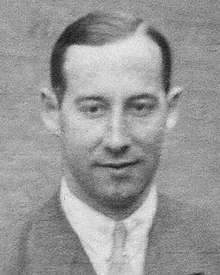Ernst Stueckelberg
Ernst Carl Gerlach Stueckelberg (baptised as Johann Melchior Ernst Karl Gerlach Stückelberg,[1] full name after 1911: Baron Ernst Carl Gerlach Stueckelberg von Breidenbach zu Breidenstein und Melsbach;[2] 1 February 1905 – 4 September 1984) was a Swiss mathematician and physicist, regarded as one of the most eminent physicists of the 20th century.[3][4] Despite making key advances in theoretical physics, including the exchange particle model of fundamental forces, causal S-matrix theory, and the renormalization group, his idiosyncratic style and publication in minor journals led to his work being unrecognized until the mid-1990s.
Ernst Stueckelberg v. Breidenbach | |
|---|---|
 Ernst Stueckelberg, 1934 in London | |
| Born | 1 February 1905 |
| Died | 4 September 1984 (aged 79) |
| Known for | Stueckelberg action Feynman–Stueckelberg interpretation Discovery of the renormalization group Semi-detailed balance Landau-Zener formula |
| Awards | Max Planck Medal (1976) |
| Scientific career | |
| Doctoral advisor | August Hagenbach |
| Doctoral students | Marcel Guénin Constantin Piron André Petermann |
Early life
Born into a semi-aristocratic family in Basel in 1905,[5] Stueckelberg's father was a lawyer, and his paternal grandfather a distinguished Swiss artist. A highly gifted school student, Stueckelberg initially began a physics degree at the University of Basel in 1923.
Career
While still a student, Stueckelberg was invited by the distinguished quantum theorist Arnold Sommerfeld, to attend his lectures at the University of Munich. He went on to gain a Ph.D. on cathode physics in 1927. Later that year he went to Princeton University, becoming an assistant professor in 1930. He was elected a Fellow of the American Physical Society in 1931.[6]
He returned to Switzerland in 1932, working first at the University of Basel before switching the following year to the University of Zurich. In 1934 he moved again to the University of Geneva, which together with the University of Lausanne became his principal bases for the rest of his career.
Stueckelberg's sojourn in Zurich led to contact with leading quantum theorists Wolfgang Pauli and Gregor Wentzel, which in turn led him to focus on the emerging theory of elementary particles.
In 1934 he devised a fully Lorentz-covariant perturbation theory for quantum fields.[7][8] The approach proposed by Stueckelberg was very powerful, but was not adopted by others at the time, and has now been all but forgotten. However, besides being explicitly covariant, Stueckelberg's methods avoid vacuum bubbles.[9]
Stueckelberg developed the vector boson exchange model as the theoretical explanation of the strong nuclear force in 1935. Discussions with Pauli led Stueckelberg to drop the idea, however. It was rediscovered by Hideki Yukawa, who won a Nobel Prize for his work in 1949 — the first of several Nobel Prizes awarded for work which Stueckelberg contributed to, without recognition.[10]
In 1938 Stueckelberg recognized that massive electrodynamics contains a hidden scalar, and formulated an affine version of what would become known as the Abelian Higgs mechanism.[11] He also proposed the law of conservation of baryon number.[12]
The evolution parameter theory he presented in 1941 and 1942 is the basis for recent work in relativistic dynamics.
In 1941 he proposed the interpretation of the positron as a positive energy electron traveling backward in time.[13]
In 1943 he came up with a renormalization program to attack the problems of infinities in quantum electrodynamics (QED), but his paper was rejected by the Physical Review.
In 1952 he proved the principle of semi-detailed balance for kinetics without microscopic reversibility.[14][15]
In 1953 he and the mathematician André Petermann discovered the renormalization group.[16]
In 1976 he was awarded the Max Planck medal.
His PhD students included Marcel Guénin.
See also
Notes
- O'Connor, John J.; Robertson, Edmund F., "Ernst Stueckelberg", MacTutor History of Mathematics archive, University of St Andrews.
- Burton Feldman, The Nobel Prize: A History of Genius, Controversy, and Prestige, Arcade Publishing, 2001, p. 193.
- Lacki, J.; Wanders, G.; Ruegg, H. (Eds.) (2009). E. C. G. Stueckelberg, an unconventional figure in twentieth century physics. Birkhäuser Verlag AG. ISBN 3-7643-8877-3.CS1 maint: extra text: authors list (link)
- Enz, Charles P. (March 1986). "Obituary: Ernst Stueckelberg". Physics Today. 39 (3): 119–121. Bibcode:1986PhT....39c.119E. doi:10.1063/1.2814942. Archived from the original on 2013-09-30.
- Biographical details based on "An overview of Stueckelberg's Life as a Scientist" by Wanders, Gérard in Lacki, Jan, Ruegg, Henri, Wanders, Gérard (eds.), E.C.G. Stueckelberg, An Unconventional Figure of Twentieth Century Physics (2009).
- "APS Fellow Archive".
- E. C. G. Stueckelberg, "Relativistisch invariante Störungstheorie des Diracschen Elektrons," Ann. d. Phys. 21 (1934), pp. 367-389 and 744.
- arXiv:physics/9903023
- "The search for a quantum field theory"
- Discussion in The Second Creation: Makers of the Revolution in Twentieth Century Physics by Crease, R, Mann, C Macmillan: 1996.
- Stueckelberg, Helvetica Physica Acta Vol. 11, 1938, pp. 299–312.
- Griffiths, David (1987). Introduction to Elementary Particles. John Wiley & Sons. ISBN 0-471-60386-4.
- Stueckelberg, Helvetica Physica Acta, Vol. 14, 1941, pp. 51-80
- Stueckelberg, E.C.G. (1952). Théorème H et unitarité de S. Helv. Phys. Acta 25, 577-580.
- Gorban, A.N., Shahzad, M. (2011) The Michaelis-Menten-Stueckelberg Theorem. Entropy 13, no. 5, 966-1019.
- Stueckelberg, E. C. G. and A. Petermann (1953). "La renormalisation des constants dans la théorie de quanta", Helv. Phys. Acta 26, 499–520.
References
- Cianfrani, F., and Lecian, O. M. (2007) "E.C.G. Stueckelberg: a forerunner of modern physics," Nuovo Cimento 122B: 123-133.
- Lacki, Jan, Ruegg, H., and Valentine Telegdi (1999) "The Road to Stueckelberg's Covariant Perturbation Theory as Illustrated by Successive Treatments of Compton Scattering." Studies in History and Philosophy of Modern Physics.
- Schweber, Silvan S. (1994) QED and the Men who Made It. Princeton Univ. Press: chpt. §10.1.